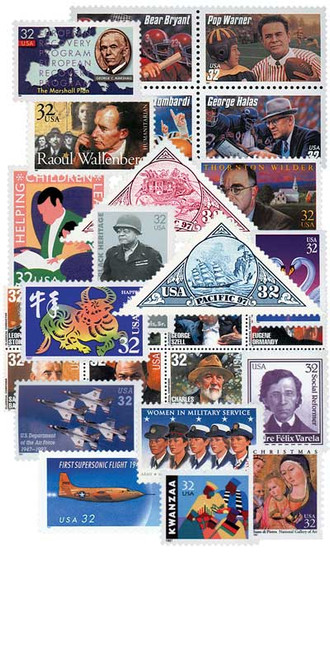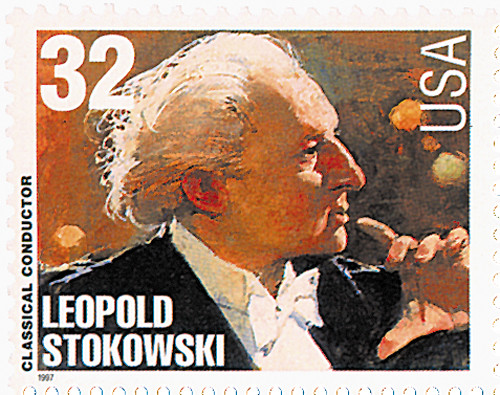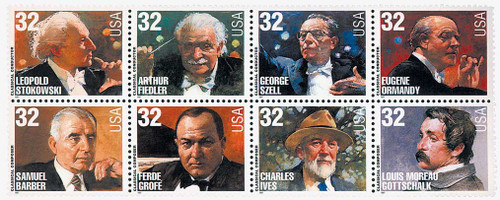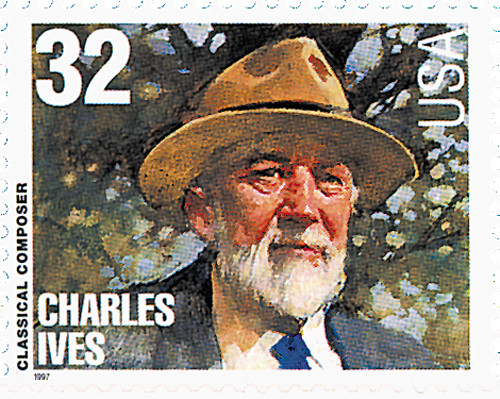
# 3162 - 1997 32c Conductors and Composers: Samuel Barber, Composer
US #3162
1997 Samuel Barber – Classical Composers & Conductors
American Music Series
- Pictures composer Samuel Barber
- Part of the Classical Composers & Conductors set
- The 10th stamp set in the Legends of American Music series
Stamp Category: Commemorative
Set: Classical Composers & Conductors
Series: Legends of American Music
Value: 32¢, First Class Mail Rate
First Day of Issue: September 12, 1997
First Day City: Cincinnati, Ohio
Quantity Issued: 86,000,000
Printed by: Printed for Ashton Potter (USA) Ltd. By Sterling Sommer of Tonawanda, New York
Printing Method: Offset
Format: Pane of 20 (Horizontal 4 across, 5 down)
Perforations: 11.1 by 11.0
Tagging: Phosphored paper
Why the stamp was issued: To commemorate composer Samuel Barber, one of the best of the best in American classical music.
About the stamp design: The stamp pictures a painting of Barber by artist Burt Silverman (also responsible for the image on the 1997 Raoul Wallenberg stamp). Art director Howard Paine said he chose Silverman because “He is a mature portrait painter… I didn’t want some glitzy, commercial, airbrush, flashy, tightly rendered kind of art…. Burt’s work is ‘painterly.’ He works in oil, and you can see dabs of color and you see brush strokes and you see the human touch.”
First Day City: The First Day of Issue Ceremony for the Classical Composers & Conductors stamps was held in Cincinnati, Ohio, at the Classical Music Hall of Fame. The city is also home to the Cincinnati Symphony Orchestra, then the fifth oldest symphony orchestra in the United States. It is also home to the Cincinnati Opera, the country’s second-oldest opera company.
About the Classical Composers & Conductors set: Issued to commemorate composers Samuel Barber, Ferde Grofe, Charles Ives, and Louis Moreau Gottschalk, as well as conductors Leopold Stokowsky, Arthur Fiedler, George Szell, and Eugene Ormandy. They were chosen to represent the best of the best in American classical music.
About the Legends of American Music Series: The Legends of American Music Series debuted on January 8, 1993, and ran until September 21, 1999. More than 90 artists are represented from all styles of music: rock ‘n’ roll, rhythm and blues, country and western, jazz and pop, opera and classical, gospel and folk. In addition to individual singers and Broadway musicals, subjects include band leaders, classical composers, Hollywood songwriters and composers, conductors, lyricists, and more. The Legends of American Music Series was a huge advancement for diversity because it honored many Black and female artists.
History the stamp represents: Samuel Barber (1910-1981) started piano lessons at age six. Within a year, he was composing. Even as a child he showed an inclination toward vocal music, as seen by his short opera The Rose Tree, which he performed with the assistance of his sister Sara.
Barber established himself as a serious composer while a student at the Curtiss Institute, which he attended for eight years. His works from this period, including the Serenade for string quartet, Dover Beach, and the Cello Sonata contain the essential ements of his style – successful text-setting and use of tone and orchestrations, as well as long lyrical lines. In 1935, Barber met the legendary conductor Arturo Toscanini. Three years later, Toscanini conducted Barber’s First Essay for orchestra and the Adagio for Strings. The latter remains his most popular work.
Barber’s music was often recognized with awards. He won the 1958 Pulitzer Prize for his four-act opera, Vanessa, and a second Pulitzer in 1962 for his Piano Concerto No. 1. His popular instrumental pieces include The School for Scandal, Capricorn Concerto, and the Concerto for Cello and Orchestra. And Knoxville: Summer of 1915 and Prayers for Kierkegaard are among his popular vocal compositions.
US #3162
1997 Samuel Barber – Classical Composers & Conductors
American Music Series
- Pictures composer Samuel Barber
- Part of the Classical Composers & Conductors set
- The 10th stamp set in the Legends of American Music series
Stamp Category: Commemorative
Set: Classical Composers & Conductors
Series: Legends of American Music
Value: 32¢, First Class Mail Rate
First Day of Issue: September 12, 1997
First Day City: Cincinnati, Ohio
Quantity Issued: 86,000,000
Printed by: Printed for Ashton Potter (USA) Ltd. By Sterling Sommer of Tonawanda, New York
Printing Method: Offset
Format: Pane of 20 (Horizontal 4 across, 5 down)
Perforations: 11.1 by 11.0
Tagging: Phosphored paper
Why the stamp was issued: To commemorate composer Samuel Barber, one of the best of the best in American classical music.
About the stamp design: The stamp pictures a painting of Barber by artist Burt Silverman (also responsible for the image on the 1997 Raoul Wallenberg stamp). Art director Howard Paine said he chose Silverman because “He is a mature portrait painter… I didn’t want some glitzy, commercial, airbrush, flashy, tightly rendered kind of art…. Burt’s work is ‘painterly.’ He works in oil, and you can see dabs of color and you see brush strokes and you see the human touch.”
First Day City: The First Day of Issue Ceremony for the Classical Composers & Conductors stamps was held in Cincinnati, Ohio, at the Classical Music Hall of Fame. The city is also home to the Cincinnati Symphony Orchestra, then the fifth oldest symphony orchestra in the United States. It is also home to the Cincinnati Opera, the country’s second-oldest opera company.
About the Classical Composers & Conductors set: Issued to commemorate composers Samuel Barber, Ferde Grofe, Charles Ives, and Louis Moreau Gottschalk, as well as conductors Leopold Stokowsky, Arthur Fiedler, George Szell, and Eugene Ormandy. They were chosen to represent the best of the best in American classical music.
About the Legends of American Music Series: The Legends of American Music Series debuted on January 8, 1993, and ran until September 21, 1999. More than 90 artists are represented from all styles of music: rock ‘n’ roll, rhythm and blues, country and western, jazz and pop, opera and classical, gospel and folk. In addition to individual singers and Broadway musicals, subjects include band leaders, classical composers, Hollywood songwriters and composers, conductors, lyricists, and more. The Legends of American Music Series was a huge advancement for diversity because it honored many Black and female artists.
History the stamp represents: Samuel Barber (1910-1981) started piano lessons at age six. Within a year, he was composing. Even as a child he showed an inclination toward vocal music, as seen by his short opera The Rose Tree, which he performed with the assistance of his sister Sara.
Barber established himself as a serious composer while a student at the Curtiss Institute, which he attended for eight years. His works from this period, including the Serenade for string quartet, Dover Beach, and the Cello Sonata contain the essential ements of his style – successful text-setting and use of tone and orchestrations, as well as long lyrical lines. In 1935, Barber met the legendary conductor Arturo Toscanini. Three years later, Toscanini conducted Barber’s First Essay for orchestra and the Adagio for Strings. The latter remains his most popular work.
Barber’s music was often recognized with awards. He won the 1958 Pulitzer Prize for his four-act opera, Vanessa, and a second Pulitzer in 1962 for his Piano Concerto No. 1. His popular instrumental pieces include The School for Scandal, Capricorn Concerto, and the Concerto for Cello and Orchestra. And Knoxville: Summer of 1915 and Prayers for Kierkegaard are among his popular vocal compositions.
















